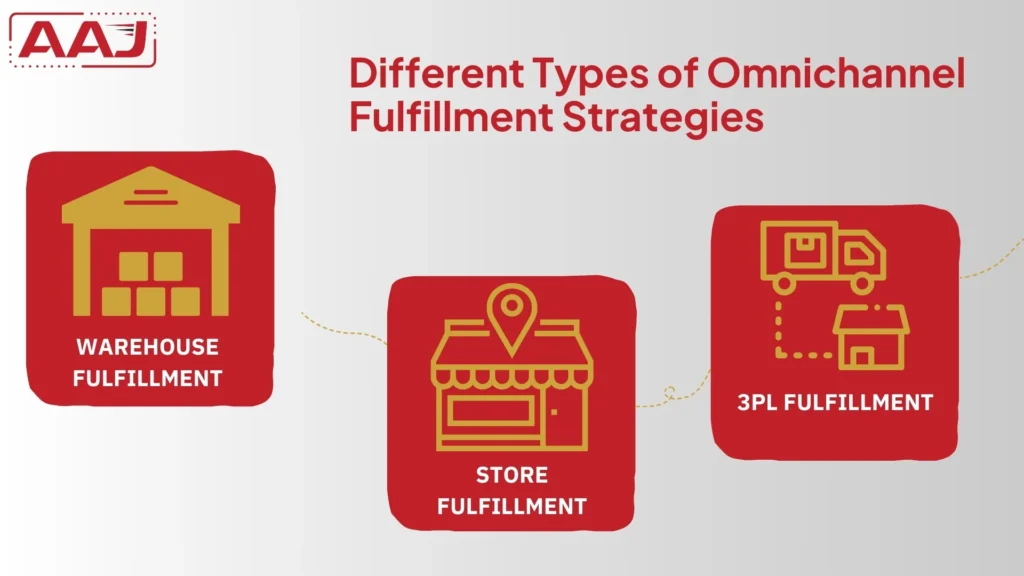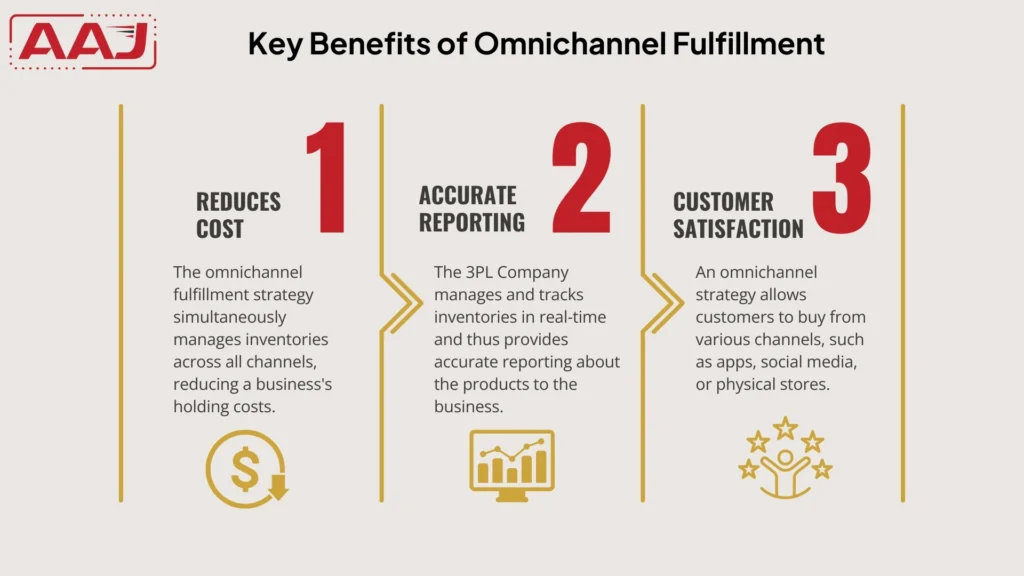Omnichannel fulfillment is a process of fulfilling customer orders from multiple sales channels, such as online stores, physical shops, and marketplaces. This process makes sure that customers can choose how and where to receive their orders, whether through home delivery, in-store pickup, or any other options. The omnichannel fulfillment approach helps companies to provide a seamless shopping experience.
In the current shopping scenario, customers expect smooth, secure, and effortless shopping experiences across multiple platforms, online or in-store. In this situation, businesses go for two separate fulfillment companies: one for B2B to fulfill retailers’ and suppliers’ orders and one for B2C to fulfill online and app orders. However, these operations can be complicated. Omnichannel fulfillment service can solve this problem efficiently. Omnichannel fulfillment companies make it easier by handling all orders, whether they are for B2B (Business to Business) or B2C (Business to Customer).
Today, more than 70 percent of consumers search numerous channels to buy one product. An omnichannel fulfillment model is a way of connecting customers through various distribution channels. The omnichannel fulfillment market is expected to grow by $11.01 billion globally by 2030.
What is Omnichannel Fulfillment?
A fulfillment strategy that connects inventory, sales channels, and delivery systems to provide a seamless shopping experience to customers across online, physical stores, and mobile platforms is called omnichannel fulfillment.
Today, customers expect their ordered product to arrive as soon as possible on their doorstep. Hence, an Omnichannel order fulfillment strategy has become crucial for every e-commerce business.
How Omnichannel Fulfillment Works?

In this fulfillment process, all inventories (in-store and warehouse) are tracked by one system that makes order management smooth and efficient. Here is the working process of Omnichannel Fulfillment:
- Unified Inventory – All inventory, whether in a warehouse, store, or fulfillment center, is managed as one. That helps customers to check product availability across locations in real time.
- Order Placement – Customers can place orders through the website, mobile app, or in-store. The advanced omnichannel system processes the order and decides the best way to fulfill it based on stock and customer location.
- Flexible Fulfillment Options – Customers can choose how they want to receive their order:
- Home delivery for convenience.
- In-store pickup for faster access.
- Same-day delivery for urgent needs.
- Seamless Returns – If a customer does not like the product and wants to return it, they can do it at the store, through an app, or by shipping it back. The system tracks the return and updates the inventory.
Advance Integrated Systems – Advanced software connects sales channels, inventory, and logistics. This ensures smooth communication between warehouses, stores, and delivery partners. That helps in reducing delays and errors.

Let’s understand Omnichannel Fulfillment through an example:
The omnichannel ecommerce fulfillment strategy is different from traditional fulfillment. It fulfills customer orders from various channels, i.e., through the website, physical store, or apps. The main aim of omnichannel fulfillment is to provide a seamless shopping experience to customers by managing inventories properly and lessening operational costs. However, businesses should have a robust supply chain operation to succeed in omnichannel fulfillment. Let’s discuss this with an example. Imagine a customer ordering a product from an e-commerce site but picking it up from a nearby physical store.
Again, for example, you order one kurti online and do not like it after delivery. You can return the kurta from the nearby physical store of that particular brand.
Different Types of Omnichannel Fulfillment Strategies

There are various types of omnichannel fulfillment strategies. We are listing them below.
1. Warehouse Fulfillment
Most e-commerce companies rent or own warehouses to store goods and products. They deliver products to the customer from the warehouse storage. However, managing your warehouse has certain disadvantages.
For example, you have to recruit more staff or buy equipment and manage utilities, which can increase complexity and costs. Leasing warehousing simultaneously can lead to high processing fees and storage costs.
2. Store Fulfillment
Store fulfillment can be of two types, i.e
- In House Store – Here, the business provides products to the store, which are shipped to the customers. The store becomes a warehouse or fulfillment center for a business. This strategy is suitable mainly for businesses that do not have money-making warehouses or lease warehouses. Small-scale business owners should utilize this strategy to achieve profits.
- Ship To Store – Here, products ship to the nearby store from the Company’s warehouses. This method has certain limitations, like the store’s limited stock visibility.
3. 3PL Fulfillment
The Company outsources the omnichannel fulfillment strategy to the 3PL fulfillment providers.
Difference between omnichannel and multichannel fulfillment
Multi Channel Fulfillment is the one where every sales channel is independent. Imagine a customer likes a product from an e-commerce site and wants to order it. But unfortunately, it is out of stock. Then, in such cases, there is no guarantee that it will be available in the store nearby for that brand.
However, in the case of omnichannel fulfillment, all the sales channels work seamlessly together and increase customer satisfaction. For example, you can order a product from an online store and pick it up from a nearby store.
Key Benefits of Omnichannel Fulfillment

There are numerous benefits of omnichannel fulfillment, which are underlined below.
1. Reduces Cost
Most E-commerce businesses store their goods and products in warehouses regarding traditional order fulfillment. Some may even rent space to store their products. Whenever your business expands, you will start delivering more than 200 products per day. Hence, you need more warehouse logistics space and manage more staff to deliver products on time.
Simultaneously, you must be required to spend more money on logistics, sales, and marketing activities. So, managing all these things requires a lot of money and effort. A business will have a money shortage in product development and exploration of international markets.
The omnichannel fulfillment strategy simultaneously manages inventories across all channels, reducing a business’s holding costs.
Again, the omnichannel strategy allows for shipping sometimes from the nearby store to the customer’s doorstep, reducing the business’s fuel costs.
2. Accurate Reporting
Most businesses use the help of 3PL company to fulfill their orders. The 3PL Company manages and tracks inventories in real-time and thus provides accurate reporting about the products to the business.
It helps a business owner identify the most active channel through which customers place orders. Again, he can identify the channels that require more improvement. Thus, it allows businesses to make wise decisions.
3. Customer Satisfaction
An omnichannel strategy allows customers to buy from various channels, such as apps, social media, or physical stores. Again, if a customer orders one product online, he can view it and get it from the nearby store.
The returns management process is even easier in an omnichannel fulfillment target. If a customer doesn’t like the product, he can return it in the nearshore. This reduces the hassle of the returning procedure, which was present in traditional order fulfillment strategies.
Challenges in Implementing Omnichannel Fulfillment
1. Inventory Management
An omnichannel fulfillment strategy manages inventories on various channels. Keeping track of everything and efficiently fulfilling customer orders can be challenging for business owners. Improper inventory management can lead to stock-out issues or overstocking problems.
2. Implementation Complexity
Omnichannel fulfillment requires seamless connection of all channels, such as physical stores, online marketplaces, apps, and many more. Maintaining all these channels can be challenging, mainly when the business deals with many products and has various channels to fulfill customer orders.
3. Upfront Costs
Utilizing an omnichannel fulfillment strategy will save a business money in the long run. However, expanding numerous fulfillment centers in India, implementing various software, and training staff can increase the Company’s upfront costs.
Proven Strategies for Effective Omnichannel Fulfillment

1. Order management System
A commerce business should invest in a robust order management system to track and manage inventories across all channels.
2. Technology Integration
A business should utilize technology like a warehouse inventory management system to manage various operations like picking, packaging, labeling, and shipping. It should even adopt a transportation management system to find efficient logistics costs. You can use data analytics to identify customer needs and requirements and make changes in your business accordingly.
3. Focus On Customers
Customers should have a memorable experience when ordering products from your e-commerce website. You should provide updates regarding product shipping and order status. An excellent customer support care team must handle all customer queries. Customers can contact customer care through various ways, such as chat, phone, or email.
4. Flexible Fulfillment Options
A business can use its physical store to deliver products to nearby customers, decreasing shipping costs. You can provide an offer to order products online and pick them up from the nearby store.
Future Trends in Omnichannel Fulfillment
- Automation can increase the speed of various warehouse operations, reduce human error, and even reduce businesses’ labor costs.
- Nowadays, customers are more conscious of environmental issues. E-commerce companies should use eco-friendly packaging or electric vehicles to transport products. This can reduce carbon footprints in the environment.
- Blockchain can increase transparency in the omnichannel fulfillment strategy.

Conclusion
Nowadays, customers are looking for various options for ordering products, such as through a website, store, online apps, and many more. An e-commerce business owner can gain many advantages through an omnichannel fulfillment strategy.
This strategy connects all the distribution channels together, increasing customer satisfaction and making the return process easy. It can even adopt automation and blockchain to reduce errors in the fulfillment strategy.




